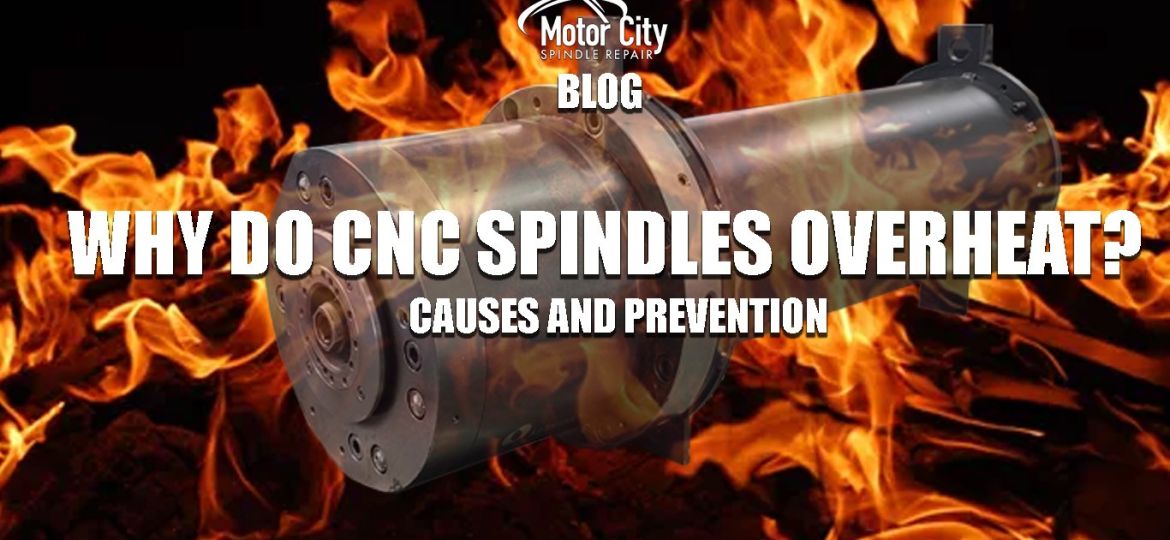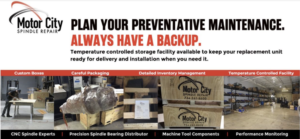
Why CNC Spindles Overheat: Causes and Prevention
CNC (Computer Numerical Control) machines are a backbone of modern manufacturing, enabling precise, automated production of components in industries like aerospace, automotive, and electronics. At the heart of these machines lies the CNC spindle—a motorized component that rotates the cutting tool. However, one common issue faced by machine operators is spindle overheating, which can lead to downtime, damaged parts, and costly repairs. Understanding why CNC spindles overheat is essential to prevent these problems and ensure smooth, uninterrupted operation.
Key Causes of CNC Spindle Overheating
- Inadequate Cooling System CNC spindles typically rely on a cooling system to maintain their operating temperature. These cooling systems can be air-based or liquid-based. If the cooling mechanism is insufficient, damaged, or improperly maintained, it will fail to dissipate the heat generated during high-speed operation. When this happens, the spindle is unable to regulate its temperature, leading to overheating.
- High-Speed Operation for Extended Periods CNC spindles are often pushed to their speed limits, especially in demanding industries. Running a spindle at high RPMs (revolutions per minute) for extended periods generates significant friction and heat. Without sufficient breaks or slower operational cycles, the spindle may exceed its thermal limits, leading to overheating.
- Excessive Load and Cutting Forces A common cause of spindle overheating is applying excessive load or pressure during the cutting process. When operators select aggressive feeds and speeds or work with tough materials, the cutting forces required increase, generating more heat in the spindle. Over time, this added stress can lead to thermal overload, especially if the machine is not optimized for such conditions.
- Bearing Issues Bearings are critical components in a CNC spindle. If they wear out or are improperly lubricated, they can create more friction and heat. Worn bearings increase the spindle’s resistance, making it work harder and generate more heat than usual. This is one of the most common mechanical reasons for overheating.
- Clogged Filters or Poor Ventilation For air-cooled spindles, proper airflow is critical. Filters can become clogged with dust, chips, and debris from machining, reducing airflow and trapping heat around the spindle. Poor ventilation inside the machine housing can also exacerbate this problem, leading to increased internal temperatures.
- Imbalanced Cutting Tools An often overlooked factor is the balance of cutting tools. If the tool is not properly balanced, it can create vibrations and imbalances during operation, causing additional strain on the spindle. These vibrations increase the workload and heat generation, leading to premature spindle failure.
Consequences of Overheating
If left unchecked, spindle overheating can cause severe damage, including:
- Bearing failure, which often results in costly repairs or replacement.
- Thermal expansion, leading to misalignment and reduced precision in machining.
- Premature wear of components, reducing the lifespan of the spindle.
- Motor burnout, causing extensive machine downtime.
Preventing CNC Spindle Overheating
- Regular Maintenance of Cooling Systems Ensuring that the spindle’s cooling system (whether air or liquid) is functioning properly is crucial. Regularly check for leaks, damaged parts, or blockages. Clean the filters, ensure that coolant is circulating efficiently, and monitor coolant levels.
- Optimize Machining Parameters Set appropriate feed rates and cutting speeds based on the material and tool specifications. Reducing the workload on the spindle and avoiding prolonged high-speed operation can significantly reduce heat generation.
- Monitor Spindle Load and Temperature Many modern CNC machines have sensors that monitor the spindle’s load and temperature. Using this data, operators can adjust machining parameters or schedule maintenance before overheating becomes an issue. If your machine doesn’t have these sensors, consider upgrading or manually monitoring the spindle temperature during operation.
- Lubricate Bearings Regularly Proper bearing lubrication is essential to reducing friction and heat. Schedule routine lubrication and bearing checks to ensure they are functioning correctly. Additionally, replace worn-out bearings promptly to avoid heat buildup.
- Use Balanced Tools Always ensure that the cutting tools are properly balanced before installing them in the spindle. Unbalanced tools not only cause vibration but also lead to additional wear on the spindle, increasing heat generation.
- Ventilation and Airflow Management For air-cooled spindles, ensure that the filters are clean, and the ventilation system is free of obstructions. A well-ventilated environment helps maintain a stable operating temperature, preventing overheating.
CNC spindle overheating is a serious issue that can disrupt production and lead to costly repairs. The good news is that with proper maintenance, optimized machining settings, and regular checks, overheating can be prevented. By understanding the common causes—such as insufficient cooling, overloading, and bearing failure—operators can take proactive steps to ensure that their CNC machines operate efficiently and avoid unnecessary downtime. A little attention to the spindle can go a long way in maintaining the overall health and longevity of your CNC equipment.
CONTACT US ANYTIME IF YOU’D LIKE TO CHAT WITH OUR EXPERTS OR STOP BY OUR 25,000 SF MANUFACTURING FACILITY LOCATED IN DEARBORN, MICHIGAN!(734) 261-8600 OR EMAIL US AT SALES@MOTORCITYREPAIR.COM

*All quotes are accompanied by a detailed failure analysis report
*We frequently repair spindles in 2-5 business days in emergency situations
*Normal time averages 1-3 weeks for standard repairs
*We keep precision bearings, seals, o-rings, encoders, and other commonly replaced spindle parts in stock and on hand
*Always available 24 hours a day and 7 days a week for emergency repair service
*We deliver the repaired product to you
*Our repairs are balanced, test ran, and certified with a full 1 Year Warranty
*We repair or build new depending on your needs
*Guaranteed cost savings
Need a FREE ESTIMATE? Click HERE To view our most recent blog post, click HERE Have questions about ballscrews? Check out our BALL SCREW WEBSITE

